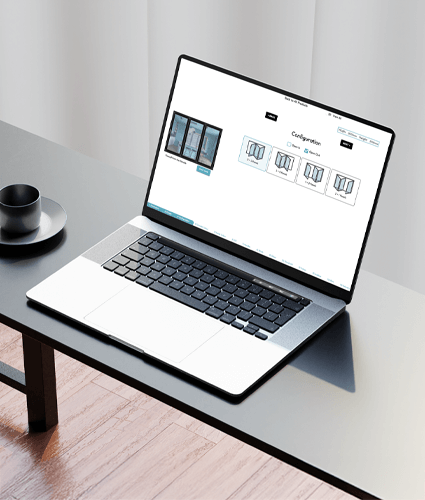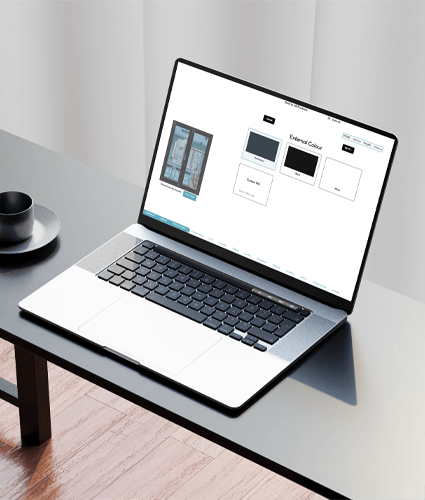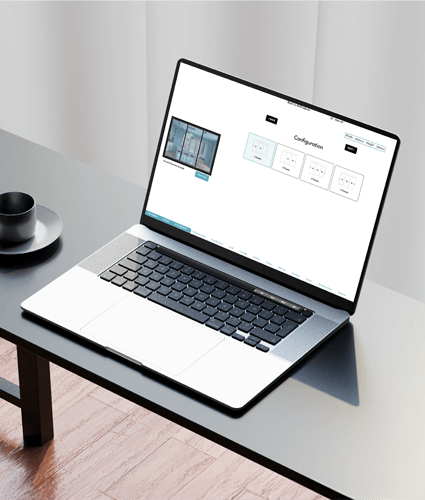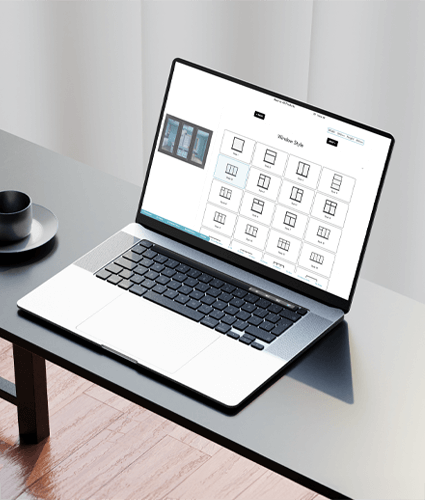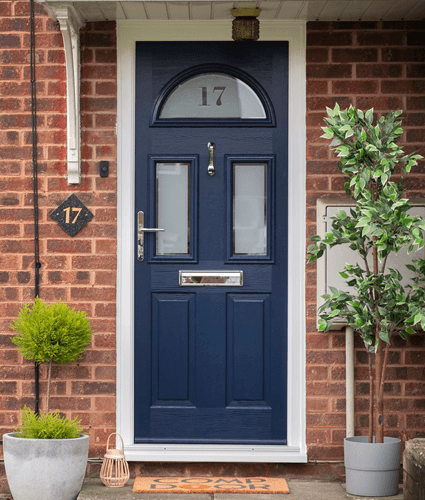
Design Your Door Here
Bifold Door Configuration and Panel Options
Bifold doors are making a strong comeback in modern homes worldwide, thanks to their space efficiency and stylish appeal. Find out the different options for bifold door configurations, sizes and panel options.
They are one of the most effective entryways for saving space in your home, providing extra floor space in confined areas like tight bedrooms, compact kitchens, and more.
Bifold doors allow natural light to flow into your home with ease, brightening up your living space and creating a cheerful atmosphere that can be enjoyed for years.
If you’re looking to save space and create a healthier, more light-filled environment, bifold doors are an excellent choice.
There are many types of bifold doors, all of which are simple to use, effective, and visually appealing. A bifold door typically has two or more panels hinged at the ends. As it opens, these panels fold easily and are placed to one side in a concertina effect.
When it’s time to close them, the panels slip out from the stack and flatten out once more, offering both functional and aesthetic benefits.
You can design your custom door online using our configurator in just a few minutes.
What Is a Bifold Door Traffic Door?
A traffic door, also known as an access door, is a component of a bifold door system that resembles a regular door. It opens and locks independently from the rest of the bifold panels, allowing you to enter and exit without having to open the entire door system.
The main purpose of a traffic door is to provide easy and convenient access between your interior and exterior spaces while keeping the rest of your bifold doors secure. In a bifold door system, the traffic door operates independently, providing simple access while the other panels can swing open to offer a broader opening when needed.
Choosing the Best Opening Options for Bifold Doors
There are numerous ways to customise your bifold doors, depending on the design preferences and functional requirements you have in mind.
Entrance Size: The larger the entrance, the larger the door. When designing your ideal aluminium bifold doors, it’s crucial to consider the opening layout before starting.
Customisation Options: These options depend on various factors, such as the number of leaves (panels), the sliding direction of your doors, and the opening and closing mechanisms.
Number of Panels: The number of door panels you need for your new bifold doors depends on the size of the door openings, your overall budget, and other considerations.
Configuration: Your door’s configuration will vary based on the bifold door size and the layout of your house. The range of opening options increases as you add more leaves, offering greater flexibility.
Bifold Door Configurations, Sizes, and Options
The way you configure and open a bifold door is largely determined by the rooms you wish to connect and the size of the available opening. Understanding your options can help you make the best choice, as bifold doors can be designed in a variety of ways.
Configuring your bifold doors involves several steps, including:
- Assessing the Area Size: Determine the dimensions of the space where the bifold doors will be installed.
- Deciding on the Number of Panels: Choose how many panels your bifold doors should have based on the size of the opening and your needs.
- Selecting Frames: Pick the type of frames that will complement your design and structural requirements.
- Traffic Door Options: Consider incorporating a traffic door for easy access without opening all panels.
- Choosing Colours and Handles: Select colours and handles that match your aesthetic preferences and home decor.
Different panel configurations have various effects and practical uses. Properly sizing your bifold doors is crucial, and knowing the standard bifold door sizes will benefit you in the long run.
2-Panel Bifold Door Configurations
For smaller areas, a 2-panel bifold door system is ideal, especially when the structural opening is limited.
This design allows the panels to fold either to the left or right, creating a full opening. Unlike a single leaf configuration, which only has one panel behind a fixed section, the 2-panel setup offers more flexibility and accessibility.
2-panel bifold doors are also an excellent option for replacing traditional French doors, providing a modern, space-saving solution.
3-Panel Bi-Folding Door Configuration
Three-panel bifold doors are popular due to their affordability and adaptability. They work well with most houses and offer three opening possibilities:
- All Doors Slide to the Right: This configuration allows all three panels to slide and fold to the right side.
- All Doors Slide to the Left: This setup lets all panels slide and fold to the left.
- Traffic Door Configuration: A traffic or access door is positioned between two sliding doors, providing easy access without opening the entire set.
These options make 3-panel bifold doors a versatile and practical choice for many homes.
4-Panel Bifold Door Configurations
For larger areas, 4-panel bifold doors offer great flexibility with various movement options. Here are some common configurations for four-panel bifold doors:
- All Panels Slide and Fold to the Right: Every panel slides and folds to the right side, creating a full opening.
- All Panels Slide and Fold to the Left: Every panel slides and folds to the left side, allowing easy access.
- Three Panels Slide and Fold Back, One Access Door: Three doors slide and fold back, while one door functions as an independent access door.
- Central French Traffic Door: A French traffic door in the center, flanked by two sliding panels on either side.
These configurations provide versatile solutions to suit different needs and preferences for larger openings.
4-Panel Bi-Folding Door Set with 3+1 Configuration
This setup includes three doors on the right and one master door. The master door swings open on hinges, latching onto a magnetic catch. It then glides open the remaining distance with the help of the handle.
6-Panel Bifold Door Configurations
6-panel bifold doors are designed for substantially larger rooms and offer great flexibility. When opening, these doors have four configuration options:
- Doors Slide to the Right: All panels slide and fold to the right.
- Doors Slide to the Left: All panels slide and fold to the left.
- Three Doors on Each Side: Three doors slide and fold on one side, and three on the other.
- Traffic Door Option: A traffic or access door is included, either on one side or another specific location.
These configurations provide versatile solutions for various needs and preferences in larger spaces.
6-Panel Corner Opening Bi-Folding Door Set – 3+3 Configuration
This configuration is ideal for extended homes. It features a traffic door in the middle, allowing ample natural light to flood the room.
One side has a 3-panel combination that opens and slides to a closed position. The other side has a 2-panel combination that follows the same sliding pattern.
Standard Dimensions for Bifold Doors
The precise dimensions of bifold doors can vary depending on the manufacturer. However, the two key specifications to consider are the width of a single panel and the combined width of all panels.
- Panel Width:
- Odd-Number Combinations: The minimum width for one door leaf is 16 inches.
- Even-Number Variants: The minimum width for one door leaf is 28 inches.
- Combined Width: The total width of all panels combined is also essential for ensuring proper functionality.
Adjusting these measurements can impact the efficiency of the sliding mechanism, so it’s important to adhere to these standard dimensions for optimal performance.
Bifold Door Materials
Choosing the right material for your bifold doors depends on the environment, look, and feel you want to achieve. Each material has its unique advantages:
Wooden Bifold Doors
- Natural Aesthetic: Wood offers a natural look and can fit both classic and contemporary designs.
- Customization: Wooden doors can be stained, lacquered, or painted in almost any colour.
- Sound Absorption: Wood helps in sound absorption, creating quieter spaces.
- Eco-Friendly: Using wood is environmentally friendly and better for the earth.
uPVC Bifold Doors
- Cost-Effective: uPVC is a sturdy, lightweight, and budget-friendly plastic material.
- Low Maintenance: It only requires a simple wipe-down to keep it looking fresh.
- Good Insulation: uPVC doors are good insulators and come in many colours and designs.
Aluminium Bifold Doors
- Structural Strength: Aluminium has better structural strength compared to uPVC.
- More Glass: It can incorporate more glass into the design.
- Ideal for Outdoors: Aluminium is ideal for doors leading to gardens or patios.
- Long Lifespan: It has a long lifespan, is easy to clean, low-maintenance, and recyclable.
Opening Direction
The placement of the lead door, which opens first and has a multi-point locking mechanism, depends on the layout.
When choosing bifold doors, the direction of the opening and whether the bifold doors open in or out is an important factor that is frequently overlooked.
Depending on the direction, the door may slide entirely in one direction, such as to the right, or it may split in two and rest on both sides. When you open the sliding door to the right, it appears easy to open and compact.
If you were to use many bifold doors, it would also function nicely. When the configuration has two panels that slide left and three that slide right, with the lead door in the middle, the lead door will sit on either side once opening.
If there is limited space inside, you have the choice to fold your doors outside to save on room.
Threshold Options
When fitting bifold doors, ensuring your doors slide smoothly is crucial for long-term use. Thresholds are the bottom tracks along which the wheels for the entire system, enabling the door panels to slide open and close.
Here are your threshold options:
- Standard Threshold: The most common choice, with a tiny upstand that offers insulation. They tend to lay lower and may require the removal of bricks at the base.
- Interior Low Threshold: Generally used for interior bifold doors, offering minimal protection against weather elements.
- Ramp-Type Threshold: Less common, these provide accessibility for those who are disabled and are typically found in public areas.
Weathered Threshold
When a bifolding door is closed, gaskets and door seals tightly against a weathered (or rebated) threshold due to the upstand. These thresholds have a weathering grade and offer reliable protection against the elements. The standard threshold is the most common option as it provides a weathered threshold.
Occasionally, a bifold door may be misplaced, making the threshold less effective. If this happens, you will need to adjust your bifold doors to ensure they fit back into place and function efficiently as before.
Colour Options
Depending on your material choice for bifolding doors, you can customize the colour and decoration to match your personal style or home architecture.
- Wooden Bifold Doors: The colour changes with the type of wood, such as oak, cedar, white pine, etc.
- Aluminium and uPVC Doors: Generally available in standard white or silver finishes, with options for matt and dual colours.
Popular Bifolding Door Handles
Your handle choice depends on personal preferences. Here are the general options:
- Stainless Steel: Durable, sleek finish, and heat-resistant.
- Aluminium: Modern design, ideal for contemporary doors and practical for renovations.
- Warmcore: A combination of aluminium and PVC, featuring curved handles.
Closing Thoughts
Bifold doors offer numerous attributes, purposes, and aesthetically appealing elements. They help provide natural light and are growing in popularity as they add extra space to homes worldwide.
The perfect design for you depends on your preferences, ranging from straightforward 1-panel configurations to more intricate ones like a 6-panel corner opening bifolding door set with a 3+3 configuration.
Bifold doors create versatile open-plan living spaces beautifully. You can use them to divide two areas, such as a kitchen and a living room, and open them up quickly when necessary.
Installing bifold doors goes beyond typical home improvement. The increased natural light and fresh air, the seamless blending of indoor and outdoor space, and the potential increase in house value are all ways bifold doors can significantly enhance your quality of life.
Frequently Asked Questions
Do bifold doors need a lot of maintenance?
No, bifold doors require very little maintenance. Typically, they only need cleaning and maintenance about once a year. This makes bifolds a great option for a back door, as most issues can be easily fixed.
What are bifolding doors made of?
Bifold doors can be made of uPVC, timber, or composite materials, depending on your preferences and environment. However, aluminium is the most commonly used material.
Can bifolding doors fold inwards and outwards?
Yes, bifold doors can be designed to open either inwards or outwards, based on your preference. When opened, the panels will either sit inside your home or open to the outside space.

